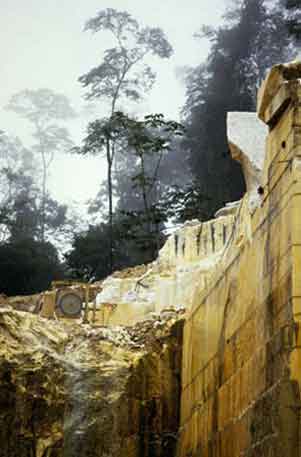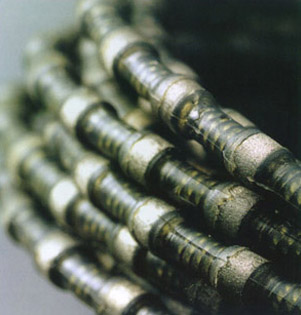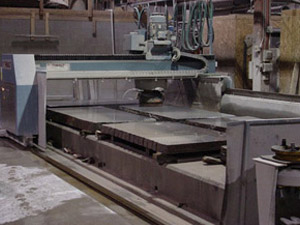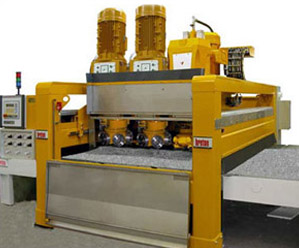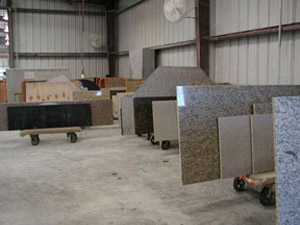Stone Flooring Construction
What makes a home is known. Creating stone flooring is another matter.
But while home consists of what’s under your roof, don’t forget what’s under your feet. Floor coverings have a huge influence on your home and home life. They impact interior beauty, décor, comfort, livability and upkeep, thus floor coverings can make or break a home.
In this section we explain how a stone is manufactured. This information can be very advantageous because it enables you to understand stone from the beginning and evaluate its performance aspects: why certain stone floors wear better and longer.
Plus, perhaps most important, understanding how a stone floor is created can help you better determine the value of stone keep you inside the borders of your budget.
Natural stone is as old as the hills.
As we said in the Welcome to Stone section, the formative process for natural stone began long ago, deep beneath the surface of the earth.
For millions of years, a combination of heat and pressure created blocks of natural stone, including granite, marble, travertine, limestone, and slate.
As the earth's crust began to grow and erode, it pushed minerals up from its core, forming massive rock deposits, which we refer to as “quarries”.
Quarries are the birthplace of today’s natural stone.
These quarries are found in many countries throughout the world such as: Italy, China, Spain, India, Canada, Mexico and the United States.
There, people who have been quarrying stone for generations, work with precision and passion, with expert selection skills, and a devotion to their craft that’s second to none.
However, science also plays a major role at the quarry.
Recent advances in the stone industry’s equipment and technology have greatly impacted the process of extracting stone from the quarry and installing it in a home.
Today’s modern tools can accomplish this with speed and efficiency.
Diamonds are the tools of choice.
At the quarry, giant blocks of stone are cut out of the earth with diamond studded, high-speed equipment.
This diamond wire cutting system has revolutionized the extraction process; a once laborious and time-consuming manual task.
More then a chip off the old block.
The blocks of stone are then moved to a processing plant where they are cut into slabs.
High-speed gang saws are used to slice the blocks into multiple slabs.
A gang saw is fitted with several blades, typically about 12 to 15 feet long, that make simultaneous parallel cuts.
If you’re wondering what happens to all the heat produced, water cools the blades while in motion and also helps control the dust.
And would you believe it takes about 2 days for a gang saw to completely cut a 20-ton block of stone?
Slab after slab, machines polish them off.
The slabs are sent through a polishing machine that puts the desired finish on the piece.
How is this done? A polishing machine operates using spindles that rotate polishing pads at high speeds over the top of the stone.
Most of these polishing machines can produce a number of different finishes, from a rough, rustic texture to a mirrored polish. These options are another one of the beauties of natural stone.
During this stage, the slab is also calibrated, meaning its surface is worked down to a relatively uniform thickness across the length of the material.
Now the fabricator makes it fabulous.
At the fabricator’s facility the slab is customized for specific installations.
Edges are shaped and polished. This is done with a series of small saws, or router bits, which are, again, diamond studded and water-cooled.
They rotate at high speeds and pass across the edge of the slab to shape the sides into the desired edge detail.
If the slab has been designated to become tiles, the slab is cut down into smaller squares such as 12” x 12”, 16” x 16”, 18” x 18” etc.
A different, more precise machine will give the tiles their final polish after they have been cut.
The tiles are then packaged, shipped and stored uniquely: they are stored vertically, never one package on top of the other.
Finally, a few words on Manufactured Stone.
(Also called Agglomerate Stone.)
This is a synthetic stone made from natural stone chips suspended in a binder such as cement, epoxy resins or polyester.
Some of the most popular types of Manufactured Stone products are those made mostly of quartz.
The natural quartz gives the product depth and radiance while at the same time strength and consistency. It offers you the look of natural stone but also can be more cost-effective.
Today, Manufactured Stone is available in a wide array of colors ranging from subtle neutrals to dazzling bright colors.
Manufactured Stone is scratch resistant but not scratch proof.
It doesn’t require sealing because it’s non-porous. That makes it highly resistant to staining, very hygienic and maintenance free.
Manufactured Stone is strong, it has four times the flexural strength of granite, so there’s less chance of chipping or cracking.
It can be used in many applications, including flooring, in all the rooms of your home.
Those are the basics of how stone flooring is made.
We hope that the information we’ve featured here leads you to a better understanding of how this beautiful and versatile product is created and underlines the fact that ancient, elegant, well-chosen stone flooring can help make your home.

